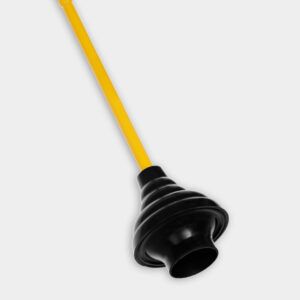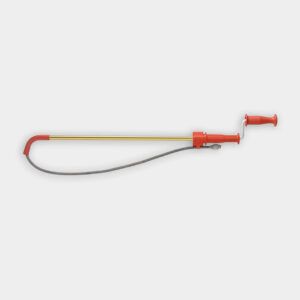We may be compensated if you purchase through links on our website. Our team is committed to delivering honest, objective, and independent reviews on home products and services.
Caused by excessive toilet paper, mineral buildup, stuck non-flushable items, or tree roots in sewer lines, a clogged toilet is one of the most common and stressful plumbing problems homeowners face. If not addressed quickly, it can lead to messy overflows and potential water damage. Fortunately, most toilet clogs are easy to fix with the right tools and techniques. This guide will walk you through several effective methods to clear a stubborn toilet clog. In the video above, This Old House’s plumbing and heating expert, Richard Trethewey, also shares valuable insights on his preferred plunging techniques.
Preparing to Unclog Your Toilet
Before attempting to clear the clog, gather the necessary tools and materials to unclog your toilet. These may include rubber gloves, towels, a bucket, a toilet plunger or auger, and ingredients for home remedies. Once you have all the materials, put on the rubber gloves to protect your hands. Place towels around the base of the toilet to soak up any water that lands outside of the bowl, and remove any excess water from the full bowl with a cup and bucket.
Using a Plunger To Unclog a Toilet
A plunger is often the fastest way to unclog a toilet, and it’s a tool most homeowners already have. With the proper technique, a plunger can clear most common toilet clogs in just a few minutes. Follow these steps for effective plunging:
- Choose the right plunger: Use a flange-style or beehive plunger designed for toilets.
- Create a seal: Submerge the plunger at an angle to allow water to fill the cup, and create a tight seal around the drain opening.
- Plunge vigorously: Use quick, forceful strokes to create suction in the toilet bowl. Trethewey recommends a pulling motion when plunging rather than pushing down. This technique can help break up clogs more effectively.
- Check results: Plunge for 20–30 seconds. Then, flush the toilet to see if the clog has cleared.
Plunger Types
Choose a plunger with enough volume to force water through the drain and a soft rubber cup that conforms to the bowl’s shape. These common plunger styles work well for toilets:
- Accordion or bellows plungers
- Beehive plungers
- Flanged cup plungers
Using a Toilet Auger To Unclog a Toilet
If plunging doesn’t work, a toilet auger, also called a closet auger, is another good option. This specialized tool can navigate the toilet’s curved trapway without damaging the porcelain and has a protective sleeve that prevents scratching, making it safer than a standard drain snake. This tool can also reach deeper clogs than a plunger.
Here’s how to effectively use a toilet auger:
- Insert the auger end into the bowl.
- Turn the handle to extend the cable into the drain.
- When you feel resistance, continue turning to break up the clog.
- Retract the cable and flush it to check the results.
Choosing the Right Auger
Toilet augers come in different lengths and designs, and some may be able to dislodge more stubborn clogs than others. Here are the most common types of toilet augers:
- Heavy-duty augers: For tougher clogs or commercial toilets, consider using a heavy-duty auger that’s longer and stronger than a standard auger.
- Power augers: These are electrically powered and ideal for severe or frequent clogs.
- Standard augers: These augers are suitable for most home toilets and are typically three to six feet in length.
Using an Auger Safely
Keep these safety tips in mind when using your auger:
- Clean and disinfect the auger after each use.
- Ensure the toilet is stable to prevent tipping.
- Turn the auger handle slowly to avoid damaging the porcelain.
- Wear protective gloves to avoid contact with bacteria.
Natural Remedies for Unclogging a Toilet
For minor clogs, you can try these gentler methods before resorting to using a toilet plunger or auger:
- Baking soda and vinegar: Add 1 cup of baking soda followed by 1 cup of vinegar, then flush with hot water after 10 minutes.
- Enzyme products: Use natural enzyme cleaners designed to break down organic matter.
- Hot water and dish soap: Pour a pot of hot (not boiling) water mixed with a few drops of dish soap into the bowl to break up the clog.
Pros and Cons of Natural Remedies
Natural remedies are more environmentally friendly than chemical cleaners, are gentle on toilet surfaces, and are easy to find and use. However, they may take longer to work than chemical cleaners and may not be effective for severe clogs.
Preventing Future Toilet Clogs
To reduce the likelihood of toilet clogs, follow these preventive measures:
- Avoid using excessive amounts of toilet paper.
- Clean the bowl regularly to prevent mineral buildup.
- Consider installing a low-flow toilet to reduce water usage.
- Only flush toilet paper down a toilet.
Maintenance Tips
Routine maintenance can keep your toilet running smoothly and prevent clogs. Here are a few ways to maintain your toilet:
- Inspect the toilet for leaks and address them promptly.
- Regularly clean the toilet’s interior and exterior.
- Replace old or worn-out parts, such as flappers and fill valves.
- Use a water softener if you live in an area with hard water.
When To Call a Plumber for a Toilet Clog
While you can get rid of most toilet clogs with do-it-yourself (DIY) methods, some situations may require professional help. If you have recurring clogs, severe backups, or sewage leaking into sinks and tubs, contact a professional plumber immediately. If you notice unusual sounds or odors coming from drains, this is also a sign to call a plumber.

